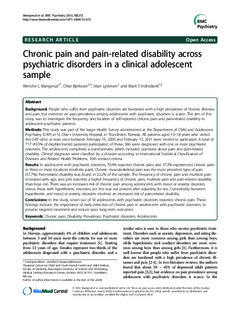| dc.contributor.author | Mangerud, Wenche Langfjord | |
| dc.contributor.author | Bjerkeset, Ottar | |
| dc.contributor.author | Lydersen, Stian | |
| dc.contributor.author | Indredavik, Marit Sæbø | |
| dc.date.accessioned | 2015-09-11T13:14:14Z | |
| dc.date.accessioned | 2015-09-28T11:23:03Z | |
| dc.date.available | 2015-09-11T13:14:14Z | |
| dc.date.available | 2015-09-28T11:23:03Z | |
| dc.date.issued | 2013 | |
| dc.identifier.citation | BMC Psychiatry 2013, 13:272 | nb_NO |
| dc.identifier.issn | 1471-244X | |
| dc.identifier.uri | http://hdl.handle.net/11250/302194 | |
| dc.description.abstract | Background: People who suffer from psychiatric disorders are burdened with a high prevalence of chronic illnesses
and pain, but evidence on pain prevalence among adolescents with psychiatric disorders is scarce. The aim of this
study was to investigate the frequency and location of self-reported chronic pain and pain-related disability in
adolescent psychiatric patients.
Methods: This study was part of the larger Health Survey administered at the Department of Child and Adolescent
Psychiatry (CAP) at St. Olav’s University Hospital, in Trondheim, Norway. All patients aged 13–18 years who visited
the CAP clinic at least once between February 15, 2009 and February 15, 2011 were invited to participate. A total of
717 (43.5% of eligible/invited patients) participated; of these, 566 were diagnosed with one or more psychiatric
disorders. The adolescents completed a questionnaire, which included questions about pain and pain-related
disability. Clinical diagnoses were classified by a clinician according to International Statistical Classification of
Diseases and Related Health Problems, 10th revision criteria.
Results: In adolescents with psychiatric disorders, 70.4% reported chronic pain, and 37.3% experienced chronic pain
in three or more locations (multisite pain). Chronic musculoskeletal pain was the most prevalent type of pain
(57.7%). Pain-related disability was found in 22.2% of the sample. The frequency of chronic pain and multisite pain
increased with age, and girls reported a higher frequency of chronic pain, multisite pain and pain-related disability
than boys did. There was an increased risk of chronic pain among adolescents with mood or anxiety disorders
versus those with hyperkinetic disorders, yet this was not present after adjusting for sex. Comorbidity between
hyperkinetic and mood or anxiety disorders involved an increased risk of pain-related disability.
Conclusions: In this study, seven out of 10 adolescents with psychiatric disorders reported chronic pain. These
findings indicate the importance of early detection of chronic pain in adolescents with psychiatric disorders, to
provide targeted treatment and reduce poor long-term outcomes. | nb_NO |
| dc.language.iso | eng | nb_NO |
| dc.publisher | BioMed Central | nb_NO |
| dc.title | Chronic pain and pain-related disability across psychiatric disorders in a clinical adolescent sample | nb_NO |
| dc.type | Journal article | nb_NO |
| dc.type | Peer reviewed | en_GB |
| dc.date.updated | 2015-09-11T13:14:14Z | |
| dc.source.journal | BMC Psychiatry | nb_NO |
| dc.identifier.doi | 10.1186/1471-244X-13-272 | |
| dc.identifier.cristin | 1065528 | |
| dc.relation.project | Samarbeidsorganet mellom Helse Midt-Norge og NTNU: 5076 | nb_NO |
| dc.description.localcode | © 2013 Mangerud et al.; licensee BioMed Central Ltd. This is an open access article distributed under the terms of the Creative Commons Attribution License (http://creativecommons.org/licenses/by/2.0), which permits unrestricted use, distribution, and reproduction in any medium, provided the original work is properly cited. | nb_NO |
